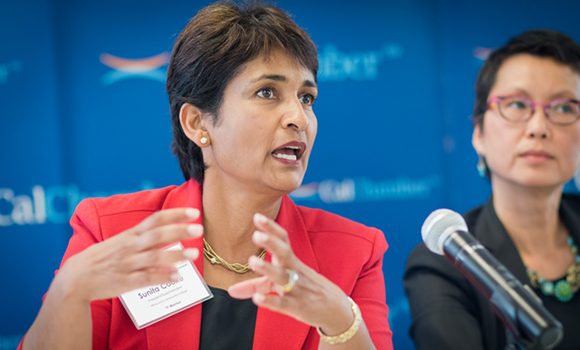
Sunita Cooke, chair of the Task Force on Workforce, Job Creation and a Strong Economy, and president and superintendent of MiraCosta Community College District (Photo Credit: Steven Hellon)
There’s a broad consensus California needs to do something about creating more middle-class jobs and workers. But as always with vast challenges, the devil is in the details, like how to pay for a new plans and how to get everyone affected by them to work together.
At a meeting of a task force working to close California’s skills gap through the community college system, it was made clear yesterday how high the stakes of getting those details right really are.
“I don’t think it’s too much of an overstatement to say that the future of the state’s economy and the future of the state rests significantly on the success of this and other efforts in the community colleges,” said Tim Gage, consultant from Blue Sky Consulting Group.
Career technical education (CTE) which includes many high-pay, in-demand jobs like nursing, IT and welding has been tapped as the main driver of this effort, given California will need 1 million middle-skill workers in the next 10 years.
The task force formed by the Board of Governors of the California Community Colleges Chancellor’s Office met for the fourth time to brainstorm ideas to help the College system adequately fund and coordinate CTE programs regionally.
The big challenge for the task force members from schools, industry and workforce development is that CTE courses can cost colleges four to five times more to offer than a traditional academic program.
But the group soldiered on and discussed ways to boost that additional funding need for CTE programs, which need expensive equipment. Their ideas will provide further direction for the Community College system and its Board of Governors on reforming the state’s CTE funding, which has been dropping for more than a decade in California.
“Traditionally how we’re funded in the community colleges is by measuring Full Time Equivalent Students, FTES’s–we call them “butts in seats”–and so we’re looking at what are alternate ways to supplement the current model,” said Lynell Wiggins, CTE counselor in the Pasadena Area Community College District.
Some of the solutions discussed, already in use in other states included tiered or differential funding, whereby state funding formulas take differential program costs into account in funding for institutions. Instead of funding “per seat,” the model provides core funding and then more for high-cost programs like CTE. Another model is using performance funding, which incentivizes increased funding based on outcomes like the increase in wages graduates earn.
The difficulty with these models, hashed out extensively during the task force meeting, is choosing which data to use to decide the additional funding, such as student demographics, the cost of programs and how it’s demonstrated they’re meeting needs of local employers.
On top of that, calculating this data is made more difficult by the fact that community college students are a diverse group of learners, spread out across varied regions, and often have different goals as students.
“One of the scariest pieces of data–and this is about measuring what matters–is skill builders were getting more jobs and at higher wages than completers,” said Sunita Cooke, chair of the task force, and president and superintendent of MiraCosta Community College District. “So I think we want to be really careful about what we’re incentivizing and driving. “
Which is why it’s so important, as the task force leaders made clear, for individual colleges to work less in a vacuum and coordinate more with other colleges in the region to align their programs and certifications.
“Without the regional coordination and understanding the needs to of regional economies, colleges won’t naturally put more investment into the area of CTE,” said Van Ton-Quinlivan, vice chancellor of workforce and economic development in the Community Colleges Chancellor’s Office. “We’ve seen that for the last decade already.”
The idea is that colleges getting on the same page regionally not only makes the college system more efficient, it makes it easier for both students and nearby employers to get what they want more efficiently.
“Unless you coordinate regionally, you’ll never get employers to engage and help the workforce and educational infrastructure adequately prepare students. They don’t have time to engage on a campus-by-campus basis,” said Jim Mayer, president and CEO of California Forward. “And from the student perspective, a lack of coordination makes it really hard for students to get what they need for their career because they can end up going to more than one college and program.”
One solution presented to the group was to make it easier for employers to voice what kind of workers need to have without having to answer questions multiple times from multiple public agencies and institutions.
“There needs to be one point of contact for all the different service providers because everybody’s coming at industry from different directions whether it’s the WIBs, community colleges, universities, EDCs,” said Mike Dozier, executive director for the Office of Community & Economic Development at CSU Fresno. “And so the industry is getting inundated by these different entities.”
The task force is gathering the ideas generated and refining language in order to make more recommendations to the Board of Governors on these problems, which have been plaguing colleges in California but have already been giving much more attention in other states.
“We have to make a difference. A million workers short is a huge gap,” said Cooke. “Through all the work that we’ve done and with the opportunity that we have in this moment in time, where everybody is looking at us to try to resolve some of the issues that have flummoxed us for decades, I would suggest that we look at impact when we prioritize these ideas.”
The Board Of Governors Task Force on Workforce, Job Creation and a Strong Economy will meet again July 29 and continues to refine the proposals this summer.

